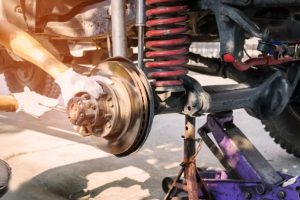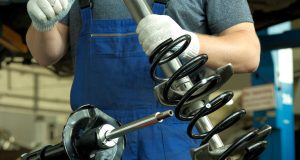Suspension springs are one of the most essential components in your vehicle’s suspension system. They play a critical role in ride comfort, vehicle stability, weight support, and overall safety. However, despite their importance, many drivers misunderstand how springs work and when they should be replaced. These misconceptions can lead to poor maintenance decisions, decreased vehicle performance, and even safety risks.
In this article, we debunk the most common suspension spring myths to help drivers better understand this vital component and maintain their vehicles more effectively.

What Do Suspension Springs Actually Do?
Before diving into the myths, it’s important to understand the function of suspension springs. These coil, leaf, or air springs are designed to:
-
Support the weight of the vehicle
-
Absorb road shocks and vibrations
-
Help maintain proper tire contact with the road
-
Work in tandem with shock absorbers to ensure smooth, controlled ride quality
Myth #1: “Springs Last Forever”
Reality:
Springs do wear out over time. While they don’t require frequent replacement like brake pads or oil filters, they can weaken, sag, or even crack due to age, load, or harsh driving conditions.
Common Signs of Worn Springs:
-
Uneven ride height
-
Vehicle bottoming out over bumps
-
Noisy suspension or knocking sounds
-
Rough or unstable handling
Tip: Check your suspension springs every 80,000–100,000 km or if you notice any of the symptoms above.
Myth #2: “You Only Need to Replace One Spring”
Reality:
Suspension springs should always be replaced in pairs — either both front or both rear. Replacing just one leads to uneven suspension performance, which can cause premature wear on tires and shocks and create an unbalanced ride.
| Replacement Option | Result |
|---|---|
| One spring only | Uneven ride height, poor handling |
| Both springs (pair) | Balanced suspension, safe performance |
Myth #3: “All Springs Are the Same”
Reality:
Springs are designed with specific rates, lengths, and materials tailored for each vehicle type and purpose (daily driving, racing, off-roading, towing, etc.). Installing incompatible springs can cause poor handling or damage to your suspension system.
| Spring Type | Characteristics | Best For |
|---|---|---|
| Linear Springs | Constant rate; predictable handling | Track and performance vehicles |
| Progressive Springs | Variable rate; soft initially, stiffer under load | Daily driving, towing |
| Leaf Springs | Used in trucks; good for heavy loads | Pickups, commercial vehicles |
| Air Springs | Adjustable; complex setup | Luxury vehicles, air suspension |
Myth #4: “Upgrading Springs Always Improves Handling”
Reality:
While performance springs can improve responsiveness and reduce body roll, they must be properly matched with shock absorbers and the vehicle’s weight distribution. Using high-performance springs on a stock vehicle without tuning the rest of the suspension can worsen handling and ride comfort.
Checklist Before Upgrading Springs:
-
Do they match your driving needs?
-
Are they compatible with existing shocks?
-
Will they impact ride height or alignment?
-
Do you need new bump stops or camber kits?
Myth #5: “Lowering Springs Are Just for Aesthetics”
Reality:
Lowering springs reduce the vehicle’s center of gravity, improving stability and cornering — when done properly. However, improperly installed lowering springs can cause issues like:
-
Reduced suspension travel
-
Increased bump steer
-
Premature tire wear
-
Rough ride over uneven roads
Tip: Combine lowering springs with matching performance shocks and professional alignment.
Myth #6: “Stiffer Springs Mean Better Performance”
Reality:
Stiffer springs are not always better. They can improve cornering but may compromise comfort and traction, especially on rough or uneven roads. A spring that is too stiff can make your tires lose contact with the road — which is dangerous.
| Road Surface | Recommended Spring Type |
|---|---|
| Smooth, paved roads | Linear or sport-tuned springs |
| Mixed/urban roads | OEM or progressive springs |
| Off-road | Soft, long-travel springs |
Myth #7: “Temperature Doesn’t Affect Springs”
Reality:
Extreme cold or heat can impact spring performance, especially in vehicles used in harsh environments. Steel springs can become brittle in sub-zero conditions, and corrosion from road salt can lead to premature failure.
Preventative Measures:
-
Apply anti-corrosion coatings
-
Inspect springs regularly in winter
-
Use OEM-quality or coated springs
Myth #8: “Spring Replacement Doesn’t Require Realignment”
Reality:
Replacing suspension springs affects the ride height, which in turn changes the suspension geometry — including camber, toe, and caster. Failing to realign the suspension after a spring change can lead to uneven tire wear and poor handling.
Suspension Components Affected by Ride Height Changes:
-
Wheel alignment (toe and camber)
-
Steering angle
-
Tire pressure and wear distribution
-
Shock absorber angle
Always perform an alignment after replacing or modifying suspension springs.
Myth #9: “All Aftermarket Springs Are Equal”
Reality:
Not all aftermarket springs are made to OEM standards. Low-cost, poorly engineered springs can cause:
-
Sagging after a short period
-
Improper fit
-
Premature failure
Choose reputable brands and certified parts. Look for warranty, fitment specifications, and compatibility with your vehicle.
Summary Table: Myths vs. Facts
| Myth | Fact |
|---|---|
| Springs last forever | They wear out due to age and load |
| Replace one spring at a time | Always replace in pairs for balance |
| All springs are the same | Different types serve different purposes |
| Upgrades always improve handling | Only if done correctly with proper tuning |
| Lowering springs are just aesthetic | They affect performance and need proper installation |
| Stiffer is always better | Too stiff can hurt ride comfort and safety |
| Temperature doesn’t matter | Extreme weather affects spring performance |
| No alignment needed after replacement | Always align after spring changes |
| All aftermarket springs are reliable | Quality varies widely — choose trusted brands |
Final Thoughts

Understanding suspension springs is essential for safe and comfortable driving. By debunking these common myths, you can make better decisions when replacing, upgrading, or maintaining your suspension system.
Whether you’re a commuter, an off-roader, or a performance enthusiast, the right knowledge will help you get the best from your vehicle’s suspension.
Buy Springs & Components online — Explore a wide range of high-quality springs tailored for all types of vehicles and driving conditions.